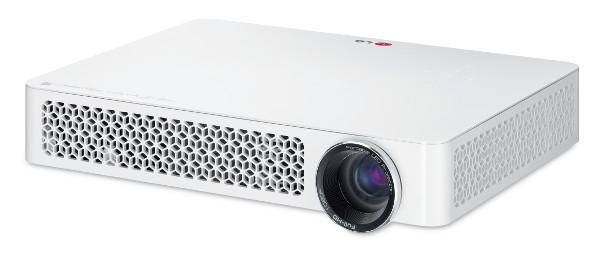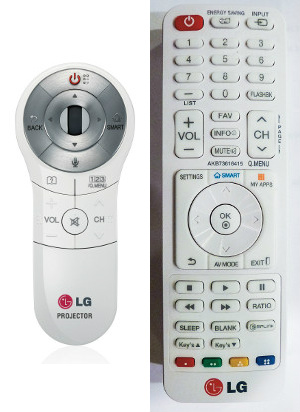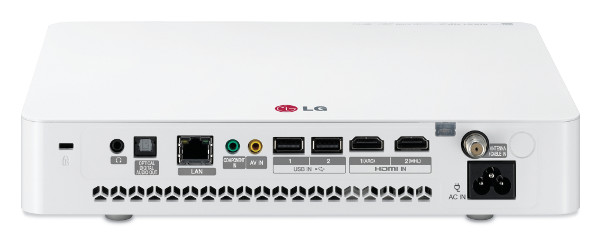LG PF85U Portable LED DLP Projector

AT A GLANCE
Plus
Crisp, bright image for a portable projector
Accurate color
Provides built-in Smart TV and streaming features
Minus
So-so black levels and picture contrast
Visible DLP rainbow effect
Limited installation options
THE VERDICT
LG’s portable PF85U has cool features and impressive picture quality for a portable projector, but its performance isn’t exactly up to snuff for regular home theater use.
LG’s PF85U DLP projector brings some interesting things to the table (literally, in many cases). It’s compact, portable, and driven by an LED light source. It has built-in Wi-Fi, LG’s Smart TV interface, and its streaming options include Netflix, Vudu, and Amazon Instant Video. At $1,199, it’s priced attractively for a 1080p-res projector with decent light output.
Of course, you can find plenty of low-priced portable LED projectors that can be easily toted along to business presentation or vacation home, but those models generally aren’t capable of putting out the kind of bright image with accurate color that a discerning viewer demands. To get to that level, you need to step up to a pricier model designed for a fixed installation. The PF85U sits somewhere in the middle of those options. It’s about the size of a cereal box and comes in a white case. Along with built-in Wi-Fi, it has two HDMI 1.4 inputs (one ARC and one with MHL), and an RF input for connecting an off-air digital TV antenna or cable. Besides Wi-Fi and MHL, there’s Miracast, WiDi, and DLNA for streaming content.
 The PF85U’s built-in speakers deliver better than average audio. Sure, the sound will distort when you push the volume to a high level, but it’s better than expected for a projector. The LG also has an optical digital output to connect to an external audio rig and even a headphone output for personal viewing.
The PF85U’s built-in speakers deliver better than average audio. Sure, the sound will distort when you push the volume to a high level, but it’s better than expected for a projector. The LG also has an optical digital output to connect to an external audio rig and even a headphone output for personal viewing.
You get two remote controls with the PF85U: a regular wand-style controller and LG’s Magic Remote. The regular remote has a non-backlit keypad and small buttons—both bad things for home theater use. The gyroscope-powered Magic Remote ends up being the better option. You can use this to point and click items in the Smart TV GUI and to also navigate setup menus. And when you click the remote’s wheel control, you get the alternative option to scroll and select items using a combination of the wheel and the arrow keys arrayed around it.
The Magic Remote also has a built-in microphone for voice-activated control. This feature mostly came in handy when I used the projector’s Web browser. The voice control lets you call out search terms instead of typing them into an onscreen keyboard—always a drag when using a remote control. And you can use the remote wheel for scrolling up and down pages. Together, these two features made Web browsing with the PF85U fairly hassle-free. That’s rarely the case with Smart TVs.
Setup
Setup is one area where the LG more closely resembles its lower-end portable projector cousins. Installation options allow for either a front- or rear-projection table or ceiling mount, but there’s no lens shift or zoom capability, so you need to position the projector at a fixed location determined by your screen’s size. I used a 16:9, 80-inch wide (92-inch diagonal) Stewart Filmscreen Cima Neve screen for my test, and the throw distance ended up being about 9.5 feet. There is automatic digital keystone correction (vertical) to help correct for a trapezoidal image if the projector can't be fired from a level even with the screen.
In my case, after mounting the PF85U on a camera tripod (a slot on the projector’s bottom permits this), it was easy enough to get the image perfectly centered onscreen and focused using the manual control on the lens. There are two “Professional” modes for storing calibrated picture settings, and the Picture menu provides plenty of high-level adjustments, including 2- and 10-point white balance; a full color management system with tint, saturation, and luminance adjustments for each color; and gamma presets.
Ultimate light output—and contrast ratio—is determined by the projector’s Energy Savings setting, which provides Minimum, Medium, and Maximum modes. Not surprisingly, Minimum savings delivers the brightest image (12.7 ft-L on a 100 IRE window test pattern), while Maximum delivers the best black level (0.008 ft-L). Contrast Ratio was about the same for all modes, topping out at 884:1 with Minimum selected. The best light output measurement I made with the PF85U was in the Vivid picture preset with Minimum Energy Savings: 19.2 ft-L on a 100 IRE window test pattern.

While Minimum Energy Savings had the best measured performance, fan noise at that setting was irritatingly high. Due to the limited setup options, the projector is bound to be squatting on a coffee table in front of you, so this is something you need to take into account. With my room completely darkened, I found that the Medium setting also delivered an acceptably bright image, but with much lower fan noise. So unless you plan to go the headphone-listening route, I’d recommend first trying that setting on the PF85U.
Performance
A big part of the PF85U’s appeal is its ability to wirelessly stream movies from Netflix, Amazon Instant, etc., so I spent a good amount of time doing just that. Kill Bill was a fun ride with the image blown up to 92 inches on the Stewart Cima screen, though compression noise and other video streaming-related artifacts detracted somewhat from the experience.
Next up: Blu-ray, specifically the disc for World War Z. In the opening scene where the family sits around the breakfast table as Brad Pitt makes pancakes, skin tones looked natural and colors accurate. In a later, more chaotic scene in Jerusalem where a frighteningly huge and fast-moving zombie horde scales a wall to attack uninfected folks on the other side, the amount of detail packed in the image effectively conveyed the epic scale of the incursion. For me, this scene alone demonstrated the value of stepping up to a 1080p model over a lesser-resolution portable projector.

Another Blu-ray I watched, an indie flick called Night Moves best described as an eco-terrorism neo-noir, also looked impressive with the LG beaming it on the big screen. The densely forested pacific northwest setting showed a rich range of green gradations, and the image looked satisfyingly bright, even with the projector’s Medium Energy Savings setting selected. Dark scenes, such as one where the terrorist trio attaches explosives to the wall of a hydroelectric dam at night, didn’t fare as well. The projector’s so-so contrast caused the dim image to look somewhat flat—deep shadows were more dark gray than black and shadow detail was limited.
One other thing that bothered me on dark scenes with the LG was DLP “rainbow effect.” DLP projectors that use LED illumination do not usually require a spinning color wheel—the source of rainbows, or intermittent flashes of colored light that mostly show up in images with high contrast—so they are usually immune from this artifact. But I spotted rainbow effect multiple times when watching with the PF85U—perhaps more so than with other DLP projectors I’ve tested.
Conclusion
LG’s PF85U is a capable, portable 1080p-rez LED-lit projector that goes beyond the call of duty to deliver reasonable brightness and accurate color. Where it comes up short in comparison to pricier models designed for a fixed installation is picture contrast and setup features that would provide a wider range of placement options. That said, the PF85U’s Smart TV and streaming features make it more immediately fun to use than other projectors, which generally lack those options. If I was looking for a budget projector to cart off to my weekend getaway, the PF85U would be on the short list.
- Log in or register to post comments

























































